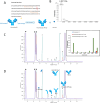Rapid identification of antibody impurities in size-based electrophoresis via CZE-MS generated spectral library
- PMID: 39215123
- PMCID: PMC11364755
- DOI: 10.1038/s41598-024-70914-5
Rapid identification of antibody impurities in size-based electrophoresis via CZE-MS generated spectral library
Abstract
Methods for the reliable and effective detection and identification of impurities are crucial to ensure the quality and safety of biopharmaceutical products. Technical limitations constrain the accurate identification of individual impurity peaks by size-based electrophoresis separations followed by mass spectrometry. This study presents a size-based electrophoretic method for detecting and identifying impurity peaks in antibody production. A hydrogen sulfide-accelerated degradation method was employed to generate known degradation products observed in bioreactors that forms the basis for size calibration. LabChip GXII channel electrophoresis enabled the rapid (< 1 min) detection of impurity peaks based on size, while capillary zone electrophoresis-mass spectrometry (CZE-MS) facilitated their accurate identification. We combine these techniques to examine impurities resulting from cell culture harvest conditions and forced degradation to assess antibody stability. To mimic cell culture harvest conditions and the impact of forced degradation, we subjected samples to cathepsin at different pH buffers or exposed them to high pH and temperature. Our method demonstrated the feasibility and broad applicability of using a CZE-MS generated spectral library to unambiguously assign peaks in high throughput size-based electrophoresis (i.e., LabChip GXII) with identifications or likely mass of the antibody impurity. Overall, this strategy combines the utility of CZE-MS as a high-resolution separation and detection method for impurities with size-based electrophoresis methods that are typically used to detect (not identify) impurities during the discovery and development of antibody therapeutics.
Keywords: Antibody; CE-SDS; CZE-MS; Degradation; Impurity; LabChip.
© 2024. The Author(s).
Conflict of interest statement
The authors declare no competing interests.
Figures






References
-
- Atsumi, Y. et al. Clip formation in the complementarity determining region of bevacizumab lowers monomer stability and affinity for both FcRn and FcγR: A comprehensive characterization of the clipped variant including its higher order structure. J. Pharm. Sci.111(12), 3243–3250 (2022). 10.1016/j.xphs.2022.08.024 - DOI - PubMed
-
- Atsumi, Y., Sakurai, N., Nishimura, K., Yamazaki, K. & Wakamatsu, K. Identification and characterization of a monoclonal antibody variant species with a clipping in the complementarity determining region isolated by size exclusion chromatography under native conditions. J. Pharm. Sci.110(10), 3367–3374 (2021). 10.1016/j.xphs.2021.05.023 - DOI - PubMed
MeSH terms
Substances
LinkOut - more resources
Full Text Sources

